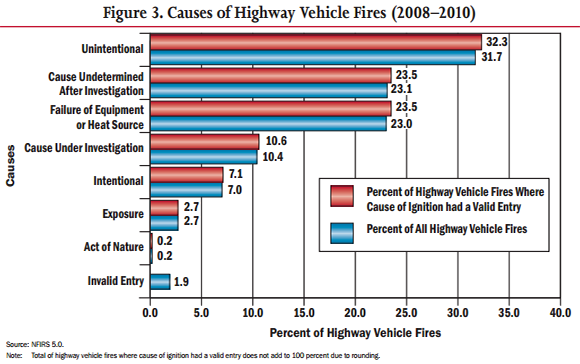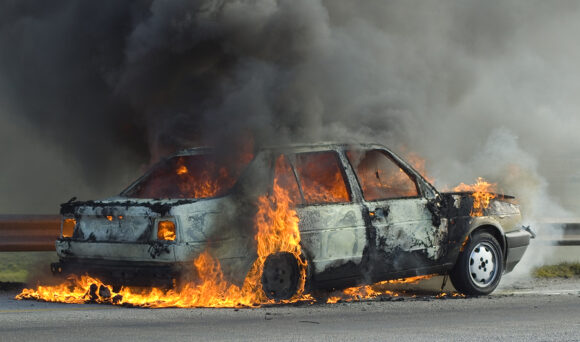Between 2008 and 2010, there were roughly 194,000 highway vehicle fires each year in the United States, according to a new report examining the characteristics of highway vehicle fires.
Accounting for 14 percent of fire department responses, the fires resulted in approximately 300 deaths, 1250 injuries and $1.1 billion in property loss, according to the report, Highway Vehicle Fires (2008-2010), developed by USFA’s National Fire Data Center and based on data from the National Fire Incident Reporting System (NFIRS).
The statistics included fires in passenger vehicles, freight transport vehicles as well as agricultural and construction vehicles.
According to the report:
- Approximately one in seven fires responded to by fire departments across the nation is a highway vehicle fire. This does not include the tens of thousands of fire department responses to highway vehicle accident sites.
- Unintentional action (32 percent) was the leading cause of highway vehicle fires.
- Eighty-six percent of highway vehicle fires occurred in passenger vehicles.
- Sixty-one percent of highway vehicle fires and 35 percent of fatal highway vehicle fires originated in the engine, running gear, or wheel area of the vehicle.
- The leading factor contributing to the ignition of highway vehicle fires was mechanical failure (44 percent).
- Insulation around electrical wiring (28 percent) and flammable liquids in the engine area (18 percent) were the most common items first ignited in highway vehicle fires.

Highway vehicle fires tend to occur in the afternoon and evening hours and there is higher occurrence of fires in summer.
The risks from motor vehicle fires are often overlooked. Toxic gases and other hazardous substances, along with flying debris and explosions, can combine to produce serious dangers.
The report is part of the Topical Fire Report Series. Topical reports explore facets of the United States fire problem as depicted through data collected in NFIRS. Each topical report briefly addresses the nature of the specific fire or fire-related topic, highlights important findings from the data, and may suggest other resources to consider for further information. Also included are recent examples of fire incidents that demonstrate some of the issues addressed in the report or that put the report topic in context.
Source: USFA
Was this article valuable?
Here are more articles you may enjoy.


 What The Return of California’s ‘Death Discount’ Means for Litigation
What The Return of California’s ‘Death Discount’ Means for Litigation  JPMorgan Wins Gender Pay Gap Dispute Against London Analyst
JPMorgan Wins Gender Pay Gap Dispute Against London Analyst  Tesla, EEOC Plan Talks to Settle Factory Racism Suit
Tesla, EEOC Plan Talks to Settle Factory Racism Suit  Musk’s X Probed by UK Over Grok’s Thousands of Sexualized Images
Musk’s X Probed by UK Over Grok’s Thousands of Sexualized Images 